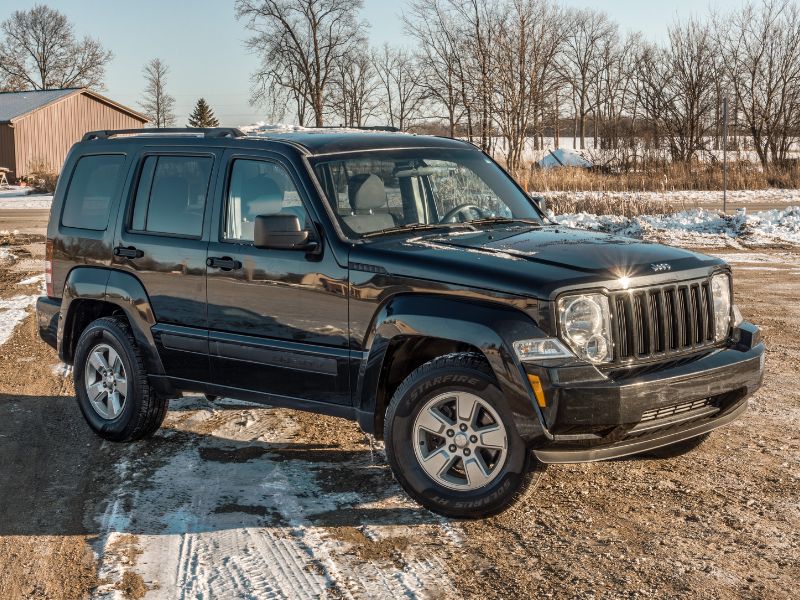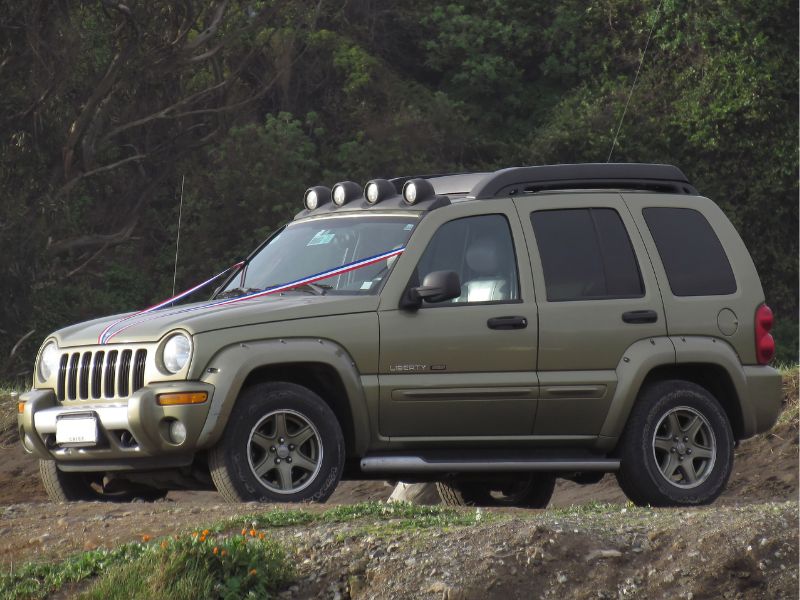Jeep is a manufacturer that caters to every segment of the SUV market, like the Liberty, which falls pretty neatly between the Wrangler and the Grand Cherokee.
If you’re looking to get one of these vehicles, you should know the common problems with the Jeep Liberty.
The Jeep Liberty is riddled with major problems that include window regulators breaking, engine failure, unwanted acceleration, airbag problems, seatbelt latch failures, and front ball joint failure.
To help you make a more informed decision, we’ve broken down these issues below and looked at some Liberty recalls you need to be aware of (especially if you have one of these models).

6 Main Jeep Liberty Problems To Be Aware Of
1. Random Window Regulator Failure
Random is a good explanation of this problem.
You don’t know which one of the 4 door windows will stop working, if it will fall into the door, or open a tiny bit, and it might happen while the car is parked or while you are driving.
While driving, the driver can get a massive fright, especially if the window falls into the door panel, which can be quite loud, followed by a lot of wind noise.
2. Engine Failure
Engine failure is mainly focused on the 3.7L PowerTech V6 gasoline engine; the engine is a ticking time bomb, even after being repaired.
The cylinder head has a major manufacturing defect that causes the valve seat, the machined part where the valve seals that can create an air-tight seal, to break free and wedge between the cylinder head and valve, causing the valve head to break off and fall into the combustion chamber, destroying the cylinder walls, head, and piston.
The worst part is it is totally random as well; one owner replaced his engine, and within the next 7,000 miles (11,265 km), it happened again, and each repair costs over US$ 5,000.
3. Unwanted Acceleration
This is a really concerning problem; when the owners depress the accelerator, the car will either continue to accelerate at the same rate as before or go to wide-open throttle.
This is most likely a faulty drive-by-wire throttle pedal, but it could also be numerous other things.
It isn’t one of the most common problems, but it is worrying that it is mentioned enough to make it onto this list.
If you react quickly enough, you can force the car into neutral and stop the car. However, some weren’t as lucky, and even by applying the brakes, the car overpowered them and drove into either garage doors, walls, or other cars.
4. Front Ball Joint Failure
Nothing puts fear in the driver of a vehicle like losing control over the vehicle, and with a ball joint failure, nothing can make you prepare for it.
In most cases, the entire wheel assembly breaks off the vehicle.
Driving at highway speeds becomes dangerous and almost unavoidable to turn into a horrible crash.
At lower speeds, the car will dig its nose into the ground and grind to a stop.
But even in a low-speed incident, it will damage more than just the suspension; it will be costly.
5. Airbag problems
Many owners complain about the airbag light coming on and staying on; in some instances, the airbags will deploy for no reason.
This can knock out the driver if the driver’s airbag deploys or disorientates the driver.
In some incidents, police found that some of the Jeep Liberty vehicles involved in accidents didn’t deploy the airbag, which is very dangerous for the vehicle’s occupants in a crash.
6. Seatbelt Latch Failure
There are cases of owners climbing into their vehicle, and one of the five-seat belts or all of them don’t want to latch to the buckle.
This is a faulty seatbelt release button that gets stuck in the open position. Thus, the seatbelt can’t latch.
This is much more of a nuisance than anything else; you can still drive but at a much higher risk of hurting yourself if you’re involved in an accident or getting pulled over by the police for not wearing your seatbelt.
Jeep Liberty Recalls
While many Jeep Libertys have been recalled, many out there were not repaired, so consider these problems when buying a second-hand Liberty.
If you own a Liberty, take your vehicle to a dedicated Jeep dealer to rectify these problems as soon as possible.
2008 Recalls
- The windshield and fixed rear quarter glass may have been assembled with the wrong urethane adhesive causing it to detach from the vehicle while driving.
- Vehicles equipped with a manual transmission parking brake drum can distort, causing it to reduce its effectiveness and cause the vehicle to start moving when parked.
2009 Recalls
- Vehicles fitted with Rock Krawler performance suspension lifts need the carriage bolts replaced; the original bolts were grade 2 bolts that can shear off and suddenly drop the vehicle and create panic for the driver and should be replaced with proper grade 5 bolts.
2010 Recalls
- 2010 manufactured vehicles may have been built with an improperly formed or missing brake booster input rod retaining clip that causes brake failure without warning.
- 2010 manufactured vehicles may have been built with improperly formed master cylinder to hydraulic control unit (HCU) brake tube assembly flare; this can cause loss of brake fluid and reduce braking performance.
- 2008 manufactured vehicles may have wiper motors that contain an excess adhesive that allows water intrusion, which can cause the wipers to stop working intermittently.
2011 Recalls
- 2011 manufactured vehicles may have been built with a missing or incorrectly installed steering column pivot rivet, which causes the steering column not to support the occupant’s loads in the event of a frontal crash.
2012 Recalls
- 2002 to 2003, manufactured vehicles may have an airbag control module that failed to deploy the airbags or just randomly deployed the airbag.
2013 Recalls
- 2011 to 2012 manufactured vehicles may have a faulty resistor in the occupant restraint control module that may lead to the non-deployment of the active head restraints during a rear impact.
2015 Recalls
- 2002 to 2003 manufactured vehicles may have a component inside the ECM fail due to electrical noise beyond the tolerance of the ECM that can cause the airbags, and seatbelt pre-tensioners to deploy randomly
2017 Recalls
- 2012 manufactured vehicles may have a component, not resistor failure, within the occupant restraint controller failure that can cause the active headrest from deploying in a rear-end crash.

Final Thoughts On Jeep Liberty Problems
While Jeep has so much promise in the SUV market range with all their different-sized SUVs, the Jeep Liberty needs to catch up with the number of problems it has.
The good news is that the NHTSA (National Highway Traffic Safety Administration) is busy with Jeep to recall the front ball joint failures.
The best thing to do if you own a Jeep Liberty is to take it to a Jeep dealership and have them check for any recalls that haven’t been completed.
If you are in the market for a used Jeep Liberty, get a full vehicle history report and avoid any models with an outstanding recall.
FAQs
Does Jeep Liberty have transmission problems?
No, while some owners experience transmission problems, it is not a common problem on the Jeep Liberty.
There is a greater chance of the engine failing than the transmission.
Why is the Jeep Liberty so cheap?
The car was riddled with problems since day one and isn’t that reliable, and with most vehicles like this, it influences the second-hand market value.
The more issues a vehicle has, the cheaper it will be second-hand.
Is Jeep Libertys good on gas?
No, the Jeep is significantly worse on fuel compared to a similar car, like the Toyota RAV4 3.5 V6.
The Jeep Liberty 3.7 V6 gets an average fuel consumption of 17 miles per gallon (13.84 liters per 100 kilometers), while the Rav4 3.5 V6 gets 24.5 miles per gallon (9.6 liters per 100 kilometers).
They both can tow 3500 pounds.

